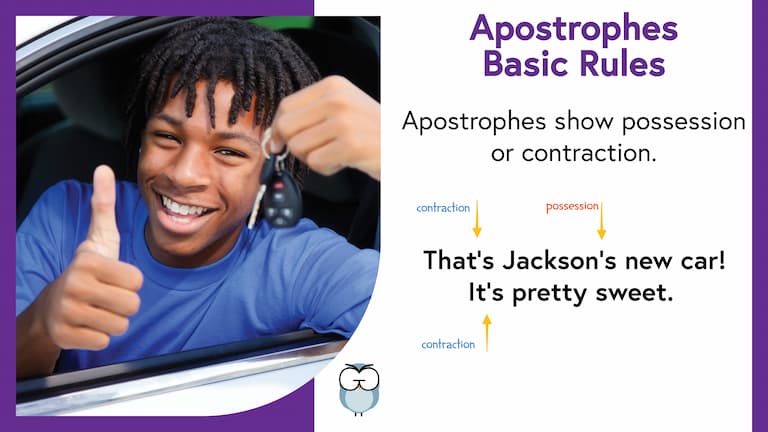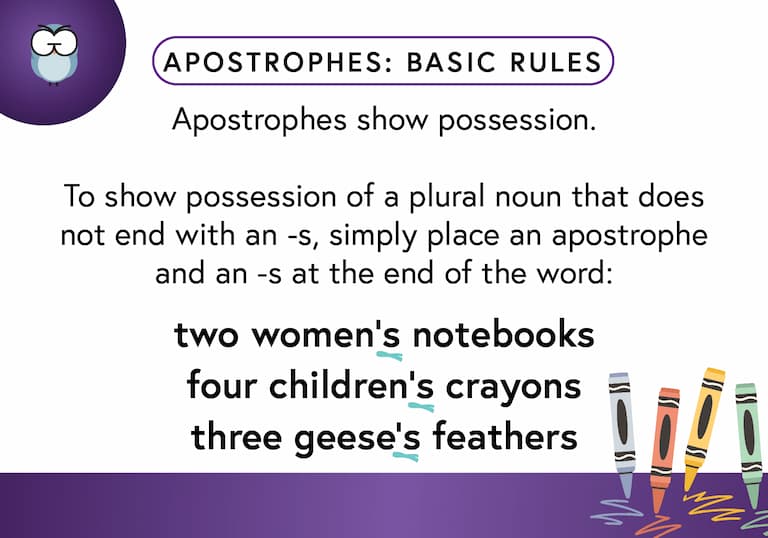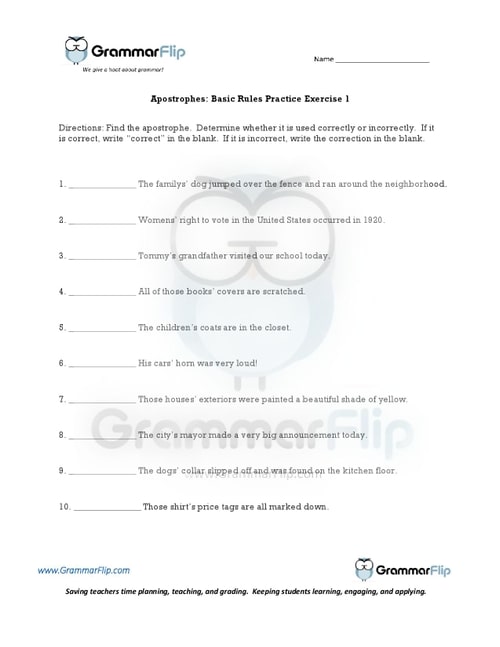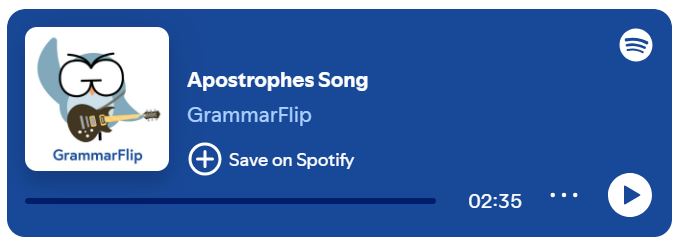What is an Apostrophe?
Apostrophes are punctuation marks that are primarily used to show possession and to indicate missing letters in a contracted word.
Rules for Apostrophes that Show Possession
To show possession of a singular noun, simply place an apostrophe and an -s to the end of the word:
Tyrone‘s bicycle, the pencil‘s eraser, the dog‘s collar
To show possession of a plural noun that already ends with an -s, simply place an apostrophe at the end of the word:
four cats‘ litter boxes, two babies‘ cribs, three teachers‘ gradebooks
To show possession of a plural noun that does not end with an -s, simply place an apostrophe and an -s at the end of the word:
two women‘s notebooks, four children‘s crayons, three geese‘s feathers
Rules for Apostrophes to Indicate Missing Letters
An apostrophe is used to indicate the placement of missing letters in a contracted word:
cannot > can’t
do not > don’t
I will > I’ll
is not > isn’t
Plural Forms of Letters and Numbers
An apostrophe is used to form the plural of a number or letter.
Mind your p’s and q’s.
There are two 7’s in my phone number.
She received all A’s on her report card.
Once you understand basic apostrophes, learn when to use apostrophes with individual ownership vs. joint ownership!
Long-Form Videos: Basic Apostrophe Rules
Long-form instructional video lessons allow students to engage with grammar concepts in more depth and detail.
This format provides students with a stronger foundation and a more comprehensive understanding of basic apostrophe rules.
Short-Form Videos: Basic Apostrophe Rules
Short-form videos are an excellent way to review grammar concepts. Our two-minute instructional videos help students review the concept of basic apostrophe rules to further solidify their understanding.
Memorable Images: Basic Apostrophe Rules

The use of images to connect visual cues with concepts makes it simpler for students to grasp and remember key ideas. GrammarFlip’s memorable images create visual associations that make basic apostrophe rules more engaging and easier to retain.
Definition Cards: Basic Apostrophe Rules
Definition cards reinforce grammar concepts by providing clear and concise explanations that students can easily reference for quick review and better retention. GrammarFlip’s definintion cards help students review the concept of basic apostrophe rules to further solidify their understanding.

Music: Basic Apostrophe Rules
Learn grammar concepts through music! The unique verses and catchy chorus in our “Apostrophes Song” will help your students further understand basic apostrophe rules. Listen for yourself and see if you don’t walk away singing this song to yourself!
Listen to GrammarFlip Music via Spotify, Apple, or Amazon!
Music Videos: Basic Apostrophe Rules
Music videos make grammar concepts more engaging and memorable by combining rhythm, visuals, and repetition to reinforce learning. GrammarFlip’s music videos help students retain the concept of basic apostrophe rules more effectively while making the learning process fun and interactive.
Download a Free Worksheet on the Basic Rules of Apostrophes!
Click the image below to download your free worksheet on the basic rules of apostrophes!

Need something more than just worksheets for your grammar instruction?
Explore More GrammarFlip Lessons!
Parts of Speech lessons provide the building blocks of grammar. GrammarFlip covers these topics in detail to ensure a solid foundation is built. First time learners and students seeking to review the parts of speech can both benefit from the instructional videos and slide show reviews.
Parts of the Sentence lessons are critical for understanding how the parts of speech function in language construction. From the basic to the advanced, these lessons will cover a wide range of grammar topics that can be used in any grade level or classroom.
Mechanics and Usage lessons equip students with the necessary skills to communicate clearly to all audiences. With a focus on the application of these concepts in student writing, these lessons tie together both simple constructions of grammar as well as the more complex such that any age or skill level of student will benefit.



